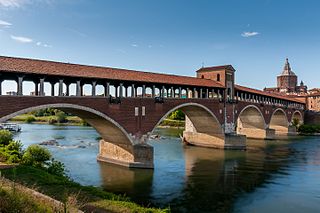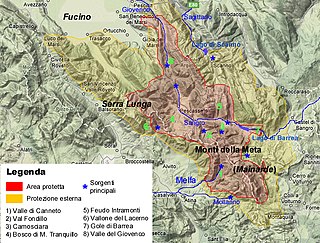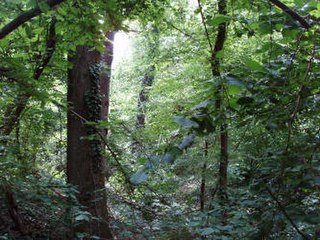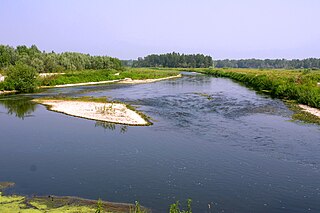
Lombardy is an administrative region of Italy that covers 23,844 km2 (9,206 sq mi); it is located in northern Italy and has a population of about 10 million people, constituting more than one-sixth of Italy's population. Lombardy is located between the Alps mountain range and tributaries of the river Po, and includes Milan, its capital, the largest metropolitan area in the country, and among the largest in the EU.

Pavia is a town and comune of south-western Lombardy, in Northern Italy, 35 kilometres south of Milan on the lower Ticino near its confluence with the Po. It has a population of c. 73,086. The city was the capital of the Ostrogothic Kingdom from 540 to 553, of the Kingdom of the Lombards from 572 to 774, of the Kingdom of Italy from 774 to 1024 and seat of the Visconti court from 1365 to 1413.

Magenta is a town and comune in the Metropolitan City of Milan in Lombardy, northern Italy. It became notable as the site of the Battle of Magenta in 1859. The color magenta takes its name from the battle.

The province of Mantua is a province in the Lombardy region of Italy. Its capital is the city of Mantua. It is bordered to the north-east by the province of Verona, to the east by the province of Rovigo, to the south by the province of Ferrara, province of Modena, province of Reggio Emilia and province of Parma, to the west by the province of Cremona and to the north-west by the province of Brescia.

Abruzzo, Lazio and Molise National Park is an Italian national park established in 1923. The majority of the park is located in the Abruzzo region, with smaller parts in Lazio and Molise. It is sometimes called by its former name Abruzzo National Park. The park headquarters are in Pescasseroli in the Province of L'Aquila. The park's area is 496.80 km2 (191.82 sq mi).

Corbetta is a comune (municipality) in the Metropolitan City of Milan in the Italian region Lombardy.

The Orto Botanico dell'Università di Pavia also known as the Orto Botanico di Pavia, is a botanical garden maintained by the University of Pavia. It is located at Via S. Epifanio, 14, Pavia, Italy, and is open to the public on weekends. The botanical garden covers an area of about two hectares and has approximately two thousand different species of plants, which are organised in sections. The current director is Francesco Sartori.The Botanical Garden stands in the place where the church of Saint Epiphanius was located, of which it preserves the cloister of the 15th century.

Circeo National Park is an Italian national park founded in 1934. It occupies a strip of coastal land from Anzio to Terracina, including also a sector of forest in the mainland of San Felice Circeo, and the island of Zannone.

The Dolomiti Bellunesi National Park is a national park in the province of Belluno, Veneto, in the northern Italy.

Visconti Park was the private park of the Visconti and Sforza families, lords, and dukes of Milan. Located in Lombardy, northern Italy, it extended between Pavia Castle and the Certosa di Pavia monastery. It covered an area of about 2,200 hectares (22 km2) and was encircled by walls about 25 kilometres (16 mi) in length. It was founded in 1360 by Galeazzo II Visconti and enlarged by his son Gian Galeazzo.

The Litorale Romano state nature reserve is a protected area in Lazio (Italy), established by the Ministry of the Environment with Ministerial Decree of March 29, 1996, which includes a large territory of historical-naturalistic interest within the municipalities of Rome and Fiumicino.
With its over 17,000 hectares, discontinuously distributed along the Lazio coast between Palidoro and Capocotta, it is the largest protected area overlooking the Mediterranean Sea. Its management is entrusted to the two municipalities in their respective sections of competence.

Monte Peso Grande o Castell'Ermo (1.092 m) is a mountain of the Ligurian Prealps, the eastern section of the Ligurian Alps.

The Strict nature reserve Bosco Siro Negri is a protected natural area owned by the University of Pavia in Italy and included in the Parco naturale lombardo della Valle del Ticino.

The Vernavola Park is a nature reserve located in the municipality of Pavia, of which it is the largest green area. The park, about 35 hectares wide, takes its name from the Vernavola stream, a small watercourse about 15 kilometres (9.3 mi) long and a tributary of the Ticino, which crosses the park with numerous meanders.

The Lakes of Avigliana Natural Park is a nature reserve in Piedmont, Italy. Established in 1980, it covers the area surrounding the eponymous maar lakes and the Mareschi swamp, in the lower Val Susa, between Monte Pirchiriano and the hill of Rivoli.

The Gran Bosco di Salbertrand Natural Park is a nature reserve in Piedmont, Italy. Established in 1980, it protects the Site of Community Importance of the Great Woods of Salbertrand, in the Val Susa, south of the Dora Riparia, between 1,000 and 2,700 meters above sea level. The woods, which cover an area of about eight hundred acres, consist of a mix of silver firs and Norway spruces, rarely found in the Western Alps.

The Campo dei Fiori Regional Park is a nature reserve in Lombardy, Italy. Established in 1984 and enlarged in 2009, it comprises the Campo dei Fiori and Martica massifs in the Varese Prealps, between the Valganna, the Valcuvia and the city of Varese.

The Paneveggio-Pale di San Martino Natural Park is a nature reserve in Trentino, Italy. Established in 1967, it stretches over nearly 20,000 ha in the Dolomites, encompassing the Pale di San Martino massif, the Paneveggio forest, and the easternmost part of the Lagorai range, between the valleys of Fiemme, Fassa, Primiero, and Vanoi.

The Parco naturale lombardo della Valle del Ticino is a Nature reserve established on 9 January 1974. It was the first Italian regional park to be established and the first European river park. The park is located along the banks of the river Ticino, in Lombardy, in the provinces of Milan, Pavia and Varese, in an area of 91,410 hectares between Lake Maggiore and the Po. The park borders the Parco naturale della Valle del Ticino, located on the other side of the river in Piedmont, created in 1978. In 2022 the two Parks were included by UNESCO in the World Network of Biosphere Reserves.




















